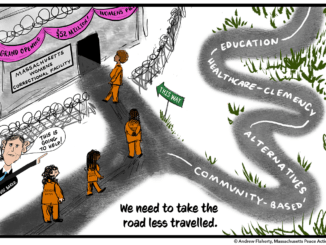
By Kathleen Malley-Morrison
Many progressive activists see today’s widespread threats to peace and social justice as residing primarily in oppression, societal structures, capitalism, and the US government. They blame social systems for preventing people from getting along. They point their fingers at broad social evils such as racism, sexism, patriarchy, oligarchy, and militarism, viewing those isms and archies as the bedrock for the fear, hatred, and violence that plague our country and the planet. Those activists are basically correct in their assumptions.
Activists have many powerful tools at their disposal to confront the military industrial complex profiteers and power-brokers—tools such as petitions, letters to the editor, demonstrations, rallies, political lobbying, nonviolent resistance, sit-ins, lie-ins, die-ins, etc. But are these tools enough to accomplish their goals? Certainly such forms of activism proved remarkably effective in the hands of Mahatma Gandhi, Nelson Mandela, Mohammed Ali, Martin Luther King, Jr.. and Thich Nhat Hanh. Undoubtedly, nonviolent resistance has inspired millions of people through the voices of Jesus Christ, Mohammad, and other spiritual leaders through the centuries. Nevertheless, today, peace and social justice feel as fragile and elusive as ever.
Ultimately, while viewing broad social forces and institutions as the primary culprits in advancing the doomsday clock, activists might benefit from expanding their toolkits. Racism, sexism, authoritarianism are not physical structures. They cannot be blasted away with dynamite or torn down by tooth and nail. The evils they produce, the violence they generate, are intimately connected to bundles of human feelings and thoughts, hearts and minds, which can be manipulated to produce the behaviors—ranging from passive compliance to deadly violence—that the power mongers want. Consequently, peace and social justice activists would do well to recognize, so that they can counteract, the types of manipulations the rulers of the military industrial complex use to manipulate hearts and minds. There is no behavior, violent or peaceful, that is not connected somehow to feelings and thoughts, hearts and minds.
Understanding feelings, thoughts, and the behaviors associated with them is a principal occupation of social and behavioral scientists, particularly psychologists. Many psychologists have devoted their research efforts to analyzing the causes and effects of participation in violence. Their findings can strengthen the messages and tactics that peace and social justice activists use to counter violence-promoting propaganda and messages of fear and hate. Their findings can also serve to educate the general public regarding the existential dangers of participating in violence, even when—or especially when—one’s government insists that violence is necessary and justified.
In regard to the participation in and tolerance of forms of violence ranging from verbal assaults to genocide, psychologists have conducted many studies revealing the tactics power mongers use to morally disengage the thoughts and feelings of ordinary people from the messages of peace and love promoted by all the major world religions and to induce those people to behave violently and without compunction. Psychologists have also identified ways to counteract those tactics and promote moral engagement in thoughts and feelings that promote efforts on behalf of peace and social justice.
Psychologists have studied the effects as well as the causes of participation in government-sponsored violence, and this research is also relevant to peace activists. For example, one of the educational strategies used by activists in their fight against government-sponsored violence involves highlighting the costs of war. As psychologists have revealed, the costs of war extend far beyond loss of life and limb in the course of battle. Long-term and recurring treatments are needed not just for physical injuries but also for psychological damage—and not just to veterans but to members of their families. Suicide among combat veterans is very high, and not just for economic reasons related to employability. If the public and publicly-elected officials are to gain an adequate understanding of the true costs of war, they need to come to grips with the staggering level of psychological injuries and the financial costs of trying to deal with those injuries. Economic and societal burden of PTSD cannot be overlooked. First-year treatment alone for Iraq and Afghanistan veterans treated through the VA costs more than $2 billion, or about $8,300 per person. This series will start next month with a focus on the costs of engaging in violence, particularly when that engagement is done under pressure—specifically, moral injury and PTSD.
— Dr. Kathie Malley-Morrison is a professor emerita of psychology at Boston University, specializing in peace studies and in life-span human development.



